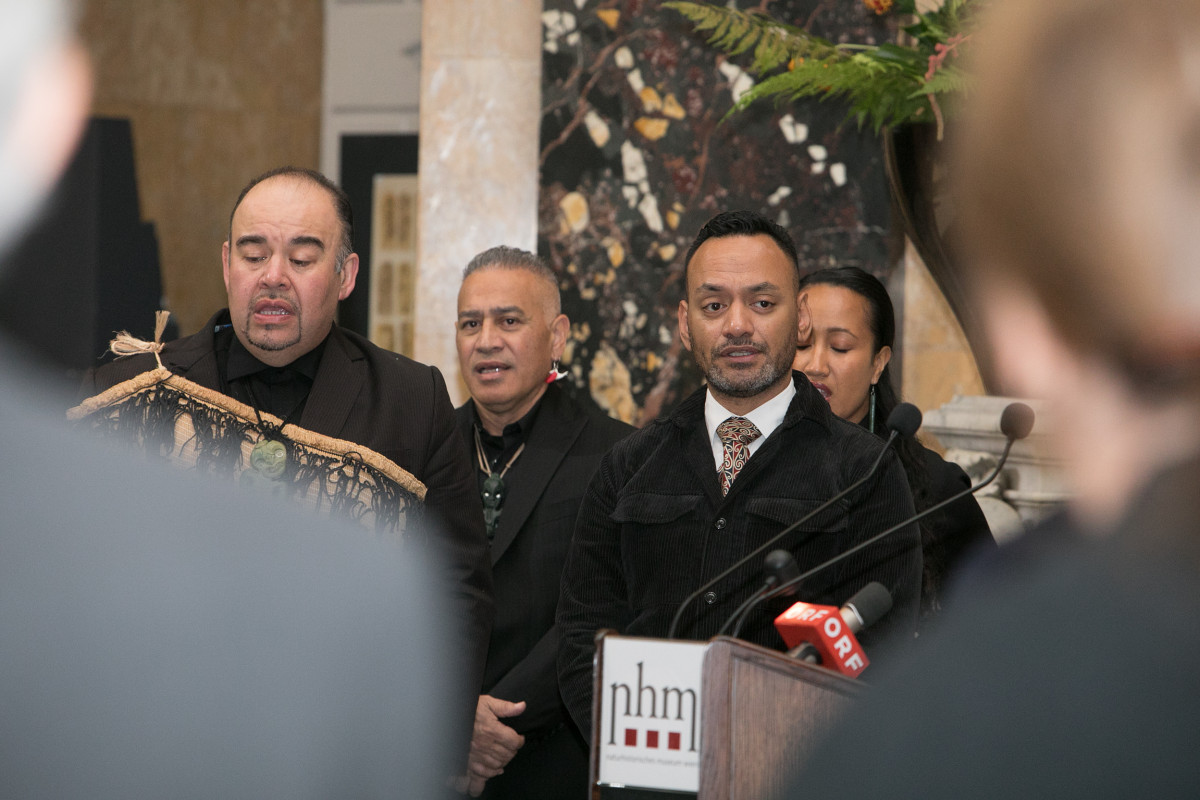The stolen human remains of 64 tūpuna Māori and karāpuna Moriori have finally been brought home from Austria to rest in peace.
A repatriation pōhiri took place at Te Papa this morning, officially marking the return of the tūpuna and karāpuna following 77 years of negotiations. It is the first repatriation to Aotearoa from the Natural History Museum in Vienna and the biggest repatriation from Austria.
The kōiwi (bones) of the tūpuna were handed back to their uri (descendants) and members of the Karanga Aotearoa Repatriation Programme on Tuesday in Vienna before making their way home.
Records show that 49 of these tūpuna were collected by renowned Austrian taxidermist and infamous grave-robber Andreas Reischek, who spent 12 years in Aotearoa from 1877 to 1889.
Reischek is famous for collecting thousands of bird specimens during his time here, but his own diary entries reveal his mistreatment of Māori cultural customs. He even befriended Kīngi Tāwhiao, the Māori king at the time, but eventually broke his trust.

Photo: Katharina Fröschl-Roßboth - Natural History Museum Vienna/APA photo service/F.-Roßboth
Professor Sir Pou Temara, Repatriation Advisory Panel Chair, says Reischek hoodwinked the King and the Māori people.
"He knew that all he needed to do was to convince the King to give permission for him to go and do what he wanted to do.
“And he didn't have any respect for the culture, for the tapu that surrounded the remains of our people, and he was able to do it from a superior cultural point of view,” Sir Pou says.
Sir Pou, along with delegations from various uri from Te Tai Tokerau, Tainui, Te Awa Tupua o Whanganui and Rēkohu (Chatham Islands), were part of the pōhiri ceremony at Te Papa.
The tūpuna and karāpuna will be interned at the wāhi tapu (sacred space) at Te Papa, and the remains that have been identified will start the process of being repatriated to their own hapū and iwi.
“Those remains that we are not able to repatriate back to hapū and to iwi, we will hold in the wāhi tapu at Te Papa until such time that the technology allows us to identify who they are,” Sir Pou says.
This provides a major opportunity to learn an important aspect of New Zealand and Māori history.
"It's imperative, in my view, for New Zealand rangatahi to understand what has happened and how we are addressing that at present," Sir Pou says.
“These are the tūpuna of rangatahi and I think very few iwi were untouched by the trade, firstly in preserved heads and in the remains of our people, of our ancestors.”

Paraone Gloyne, Te Herekiekie Herewini and Te Arikirangi Mamaku-Ironside - Photo: Natural History Museum Vienna/APA photo service/F.-Roßboth
“An emotional and significant experience”
Te Arikirangi Mamaku-Ironside, acting head of repatriation at Te Papa, was part of the delegation who collected the tūpuna and karāpuna in Austria.
He says this process has been intergenerational, beginning with the first petition from the Ōtene whānau to repatriate the remains at the end of WWII.
“It's quite [an] emotional and significant experience.”
Te Arikirangi says the Austrian officials took care throughout the process.
“There was actually a very deep heartfelt apology from Professor Dr Sabine Egger, Curator of the international osteological collection at the National History Museum.
“Mō te hē, mō te mamae ka utaina ki te iwi Māori."
(“For the wrongdoings, for the pain inflicted on the Māori people.”)
 Professor Dr Sabine Egger giving an apology - Photo: Katharina Fröschl-Roßboth - Natural History Museum Vienna/APA photo service/F.-Roßboth
Professor Dr Sabine Egger giving an apology - Photo: Katharina Fröschl-Roßboth - Natural History Museum Vienna/APA photo service/F.-Roßboth
“It’s all part of a healing process for all of us to be involved in, but first and foremost it's providing that opportunity ki te tangi, ki te mihi, ki te karanga atu ki ō tātou tūpuna,” Te Arikirangi says.
(“To mourn, acknowledge and call out to our ancestors.”)
But there is a bigger journey ahead for Karanga Aotearoa and groups working to repatriate tāonga from institutions around the world.
Te Herekiekie Haerehuka Herewini, repatriation manager at Te Papa, also travelled home with the tūpuna and karāpuna. He says there is a lot more to be done.
“There's still around 400 of our tūpuna and karāpuna that are still in institutions in Europe and North America.
“We're still [going] through the process of negotiating and repatriating those tūpuna and karāpuna,” he says.

Te Herekiekie Herewini in Vienna - Photo: Katharina Fröschl-Roßboth - Natural History Museum Vienna/APA photo service/F.-Roßboth
Te Herekiekie says each ceremony they do in Europe makes it easier to connect with other institutions.
“It sort of makes it easier for us to negotiate because it allows other institutions that are networked with each other around Europe to make it easier for them to consider,” he says.
For now, there is a huge spiritual relief that these particular tūpuna and karāpuna have returned home.
“It's really important that our kaumātua (elders), our pakeke (adults) teach our rangatahi the importance of te taha wairua (the spiritual side) and our connection to our tūpuna and our taonga,” Te Herekiekie says.
More stories:
Face value: The petition to remove the Monarchy from our money
"We've got a couple of years now to figure out what symbols represent us as a country.”
Now is the time to give a shit about women’s rugby
"I know that it's always a really different experience when you play in front of a big crowd."
Iran protests: ‘This is bravery and power personified’
In Farsi we call them shir zan. Lion women.